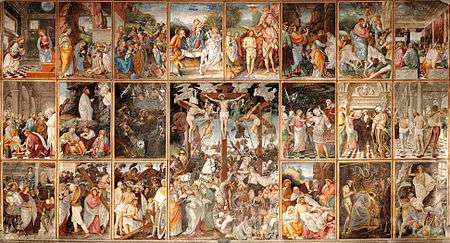Woes of the Pharisees
_-_James_Tissot.jpg)
The Woes of the Pharisees is a list of criticisms by Jesus against scribes and Pharisees in the Gospel of Luke 11:37-54 and Gospel of Matthew 23:1-39.[1] Mark 12:35-40 and Luke 20:45-47 include warnings about scribes.
Eight are listed in Matthew, and hence Matthew's version is known as the eight woes. These are found in Matthew 23 verses 13, 14, 15, 16, 23, 25, 27 and 29. Only six are given in Luke, whose version is thus known as the six woes.
The woes mostly criticise the Pharisees for hypocrisy and perjury. They illustrate the differences between inner and outer moral states.[1]
Context and background
| Events in the |
| Life of Jesus according to the Gospels |
|---|
 |
|
In rest of the NT |
|
Portals: |
The woes do not occur in the same point of the narrative in the Gospels of Matthew and Luke. In Matthew they occur shortly before Jesus returns to Jerusalem for his last few days before being crucified, while in Luke they occur shortly after the Lord's prayer is given and the disciples are first sent out over the land. Before introducing the woes themselves, Matthew states that Jesus criticized them for taking the place of honor at banquets, for wearing ostentatious clothing, for encouraging people to call them Rabbi.
The woes are all woes of hypocrisy and illustrate the differences between inner and outer moral states.[1] Jesus portrays the Pharisees as impatient with outward, ritual observance of minutiae which made them look acceptable and virtuous outwardly but left the inner person unreformed. See also Letter and spirit of the law.
The eight woes
The eight woes of hypocrisy are:
- They taught about God but did not love God — they did not enter the kingdom of heaven themselves, nor did they let others enter. (Matt 23:13)
- They devoured widows' houses and for a pretence made a long prayer, for which they would receive a greater damnation. (Matt 23:14)
- They preached God but converted people to dead religion, thus making those converts twice as much sons of hell as they themselves were. (Matt 23:15)
- They taught that an oath sworn by the temple or altar was not binding, but that if sworn by the gold ornamentation of the temple, or by a sacrificial gift on the altar, it was binding. The gold and gifts, however, were not sacred in themselves as the temple and altar were, but derived a measure of lesser sacredness by being connected to the temple or altar. The teachers and Pharisees worshiped at the temple and offered sacrifices at the altar because they knew that the temple and altar were sacred. How then could they deny oath-binding value to what was truly sacred and accord it to objects of trivial and derived sacredness? (Matt 23:16-22)
- They taught the law but did not practice some of the most important parts of the law — justice, mercy, faithfulness to God. They obeyed the minutiae of the law such as tithing spices but not the weightier matters of the law. (Matt 23:23-24)
- They presented an appearance of being 'clean' (self-restrained, not involved in carnal matters), yet they were dirty inside: they seethed with hidden worldly desires, carnality. They were full of greed and self-indulgence. (Matt 23:25-26)
- They exhibited themselves as righteous on account of being scrupulous keepers of the law, but were in fact not righteous: their mask of righteousness hid a secret inner world of ungodly thoughts and feelings. They were full of wickedness. They were like whitewashed tombs, beautiful on the outside, but full of dead men's bones. (Matt 23:27-28)
- They professed a high regard for the dead prophets of old, and claimed that they would never have persecuted and murdered prophets, when in fact they were cut from the same cloth as the persecutors and murderers: they too had murderous blood in their veins. (Matt 23:29-36)
See also
References
External links
| Wikimedia Commons has media related to Dispute with the Pharisees. |